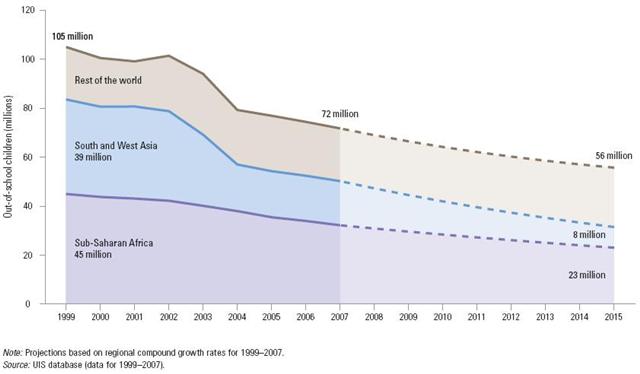![]() Over the last decade an increasingly influential independent annual report releases what is in effect the world's 'scorecard on education'. Like a student who awaits their end of year grades with trepidation, those that follow education development await the 1st March for the publication of the EFA Global Monitoring Report (GMR) with great interest.
Over the last decade an increasingly influential independent annual report releases what is in effect the world's 'scorecard on education'. Like a student who awaits their end of year grades with trepidation, those that follow education development await the 1st March for the publication of the EFA Global Monitoring Report (GMR) with great interest.

Has the global 'out of school' child population been reduced? The GMR last year reported that in 2007, some 72 million children were out of school, a 28% decline from the start of the decade. While the trend is down, we are now mid way between 2000 and 2015, and the MDG target of getting all kids into primary school is seriously off track. Not least due to the seemingly intractable problems in certain countries and regions affected by conflict or where governments simply don't exist or are incapable of providing basic services such as schooling.
It is notable that there is a major time-lag of three or more years between reporting global education statistics and the current year. In addition to thought provoking analysis, the GMR has large appendices that provide data on every country and region in the world. These originate from the UNESCO Institute of Statistics in Canada that has the unenviable job of collating, standardising and crunching this voluminous data from around the world. The long term trends in the GMR are of interest, for example the good progress made by large African countries such as Ethiopia and Tanzania, while Nigeria has made little impact in getting more children in to school in the past decade. Perhaps they should utilise the graphic wizardry I featured recently in Prof. Hans Rosling's GapMinder World to visually articulate these trends?
To some extent I have specialised in supporting national efforts to improve education statistics and know how these information problems originate. Just last week I was in a meeting at the local UNESCO office, where, with staff from the Zimbabwean Ministry of Education, we discussed how to collect and disseminate student enrolment data for the last three years, as nothing has been formally published since 2006.
Interestingly the UNESCO Paris-based EFA GMR team in recent years have increasingly concentrated on the hard to reach 'hot spots' with a focus on education and governance (2009), marginalisation (2010) and now conflict in this year's 2011 report. It's not just a question of pumping in aid money, but also tackling underlying issues of inequality, corruption and weak institutions that prevent countries developing. I experienced this first hand in Nigeria, where the paradox existed of a huge under-utilised government Universal Basic Education Fund and the largest number (7m+) of out of school children in the world.

During the recent crisis of 2008/09 in Zimbabwe there was little coverage on school closures in comparison to headlines announcing cholera epidemics, but the long term impact of missed education can be heavy. Recent research on Zimbabwe's falling HIV infection rates interestingly cited the high levels of literacy as a factor which made prevention and behaviour change campaigns effective. Education acting in effect as a 'cushion', mitigating the harmful consequences of conflict.
The World Education Blog, run by the GMR team already has some compelling stories to tell on the effects of conflict on education, be it displaced refugees and child soldiers in the Democratic Republic of Congo or the promise of long awaited change in South Sudan following the recent referendum on secession. Be sure to browse the full GMR 2011 Education and Conflict report today.

1 comment
Comment by Taleen posted on
The newly released 2011 Education for All Global Monitoring Report (GMR) details how the humanitarian community is failing to provide critical educational needs to 28 million children around the world. This year’s report sets out a comprehensive agenda for change, including tougher action against human rights violations, an overhaul of global aid priorities, strengthened rights for displaced people and more attention to the ways education failures can increase the risk of conflict.
To read an article on the 2011 GMR and UNICEF’s role in strengthening access to and quality of education, please visit http://www.educationandtransition.org/resources/new-report-details-armed-conflicts%e2%80%99-toll-on-education-and-calls-for-a-boost-in-international-aid/.